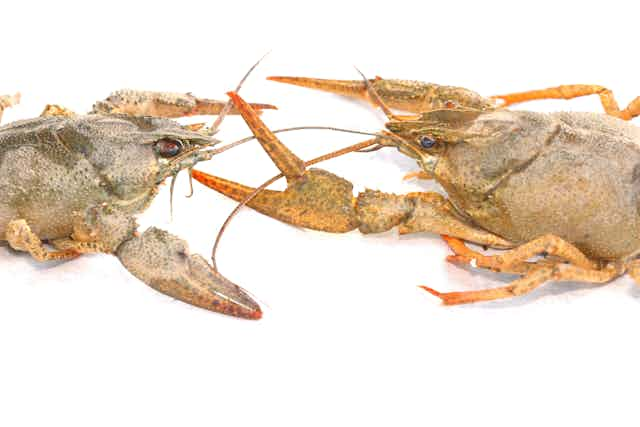Hierarchies are everywhere. It is often argued that they are a social construct, invented to allow certain people (such as white men) to have power over others. But not everyone agrees. While promoting his new book, 12 Rules for Life: An Antidote to Chaos, psychology professor Jordan Peterson, of the University of Toronto, has sparked debate by arguing that hierarchies are in fact natural to some extent.
To prove his point, Peterson uses the example of lobsters, which humans share a common evolutionary ancestor with. Peterson argues that, like humans, lobsters exist in hierarchies and have a nervous system attuned to status which “runs on serotonin” (a brain chemical often associated with feelings of happiness).
The higher up a hierarchy a lobster climbs, this brain mechanism helps make more serotonin available. The more defeat it suffers, the more restricted the serotonin supply. Lower serotonin is in turn associated with more negative emotions – perhaps making it harder to climb back up the ladder. According to Peterson, hierarchies in humans work in a similar way – we are wired to live in them. But can a brain chemical really explain the organisation of a human society?
Lobsters versus humans
It is true that serotonin is present in crustaceans (like the lobster) and that it is highly connected to dominance and aggressive social behaviour. When free moving lobsters are given injections of serotonin they adopt aggressive postures similar to the ones displayed by dominant animals when they approach subordinates. However, the structures serotonin can act on are much more varied in vertebrates with highly complex and stratified brains like reptiles, birds and mammals – including humans.
If nervous systems were computer games, arthropods like lobsters would be “Snake” on a first-generation mobile phone and vertebrates would be an augmented reality (AR) game. What AR allows us to do and feel are incomparable to Snake, and the mechanisms behind it are a lot more complex. For example, one of the most relevant brain structures for dominant social behaviour is the amygdala, located in the temporal lobe of primates including humans. Arthropods don’t have an amygdala (lobsters don’t even have a brain, just an aglomerate of nerve endings called ganglia).
There are more than 50 molecules that function as neurotransmitters in the nervous system including dopamine, noradrenaline, adrenaline, serotonin and oxytocin. These molecules, however, exist all over nature. Plants have serotonin. In animals (including humans), most of the serotonin is produced and used in the intestine to help digestion. It’s the structure where it acts that determines its effect.
The same neurotransmitter can have contrasting effects in different organisms. While lower levels of serotonin are associated with decreased levels of aggression in vertebrates like the lobster, the opposite is true in humans. This happens because low levels of serotonin in the brain make communication between the amygdala and the frontal lobes weaker, making it more difficult to control emotional responses to anger.

So not only does it seem unlikely that low levels of serotonin would make humans settle in at the bottom of a hierarchy, it goes to show that lobsters and humans are just not a great comparison.
Peterson, however, claims that the nervous systems of humans and lobsters are in fact so similar that antidepressants work on lobsters. One such drug, Prozac, has been shown to block serotonin uptake into serotonergic nerve terminals in lobsters. So yes, because the molecule is the same and the nerve terminals are very similar, the drug does what it was designed to do. But it did not make lobsters happier.
Plastic brains
Peterson argued on the UK’s Channel 4 News that “it’s inevitable that there will be continuity in the way that animals and human beings organise their structures”.
However, we know that the human brain is hugely malleable and that behaviour and society can influence how it develops. Even how much serotonin we produce is a product of many interior and exterior factors. For example, “stereotype threat” is a process by which people feel anxiety about skills that they perceive to be associated with members of another group. We know such negative feelings actually change brain activity. One study showed that people who perceived themselves as being of lower status than others had different volumes of grey matter in brain regions involved in experiencing emotions and reacting to stress than those who did not.
So believing that it is “natural” that some people are “losers” because that’s what lobsters do can have dire consequences. Some people may continue to see themselves as inferior to the guy who bullied them in school, while their brains adapt to this “reality”. If we instead chose to believe that all humans are unique and equal – and we have the power to make society fairer – this will change our brains too. It is a clear example of how attitudes can alter both brains and behaviour.
Regarding “continuity”, there is continuity in evolution the same way that there is continuity in families. Your grandparents “continue” through your parents and these “continue” through you. Our last common ancestor with the lobster was an animal that existed 350m years ago and it was the first animal that developed an intestine. This is the main organ we have in common – not serotonin and definitely not the nervous system.
We can wish to hold on to the past and choose to emulate the societal structure of ancient animals. But the fact lobsters have survived for so long without changing is a reflection of how well they are adapted to their environment – and how little this has changed. Human ancestors have left the ocean, developed lungs, vocal cords and many things in between. We have explored continents, built flying machines and some of us even live outside the Earth. We crave change and challenge. We also try to make our societies more fair and balanced and aspire to make humanity better and more advanced.
What’s more, the animal kingdom is full of examples of hierarchies, with the highest level of organisation observed in insects. These are as closely related to us as lobsters are – they also have serotonin and nervous systems. In the world of bees, the queen is much larger than the males and the only fertile female. She lays all the eggs in the colony after being fertilised by several males. After breeding season, the males are driven out of the colony and die. If we chose to organise society in this “natural” way, would we be okay with that?

